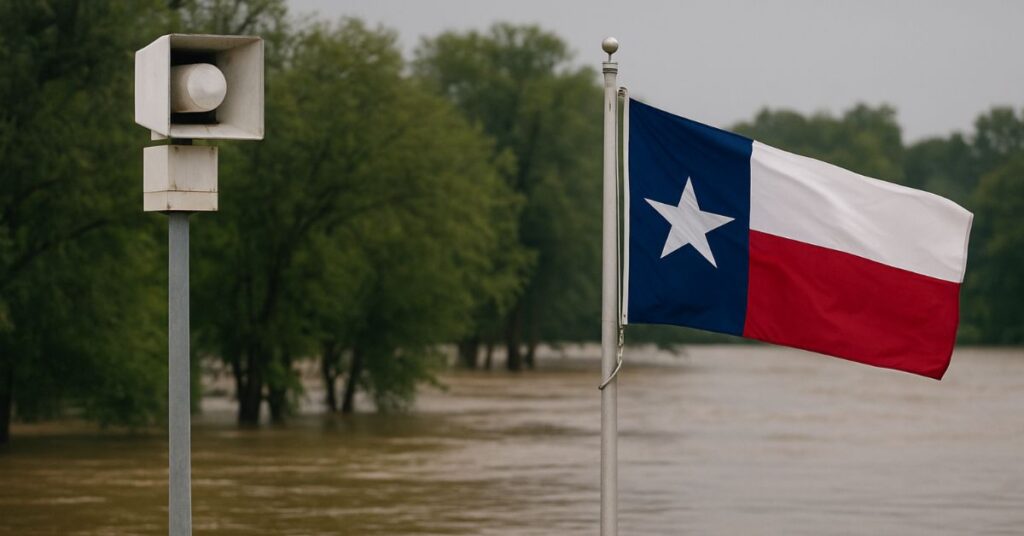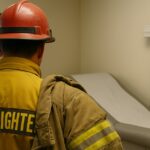On the July 4th weekend, 2025, catastrophic flash floods swept through the Texas Hill Country, claiming at least 137 lives and leaving several people still missing. The tragedy struck hardest in Kerr County, where the absence of flash-flood warning sirens left residents with no advance notice as walls of water rushed through what’s historically known as Flash Flood Alley.
This tragedy has become one of the deadliest U.S. flood events in decades. It has also exposed the fragmentation of the emergency response system, leaving critical gaps in emergency warning systems that directly impact the safety of both residents and the first responders who risk their lives to save them.
The Texas legislature has already begun addressing this through a promising new Senate Bill that aims to close the critical gaps in emergency warning infrastructure.
What Senate Bill 2 Proposes
Crafted by Senator Paul Bettencourt, Senate Bill 2 (SB2) would establish comprehensive flood warning infrastructure:
- Siren Installation: Authorize flood emergency sirens in at-risk counties, rural zones, RV parks, camps, and unincorporated communities.
- Advanced Technology: Include flood gauges, sensors, and connectivity infrastructure beyond basic sirens.
- Communication Backup: According to Senator Bettencourt, “we will be looking at trying to tie this together with towers that can have a satellite backup link or a 5G link because down in the canyons, you can’t get cell service.”
These proposals represent radical changes versus the current status quo, and they come with a promise of rapid deployment: the goal is to have them ready within a year, before the next flood season starts.
What’s perhaps more impressive is the level of bipartisan political support enjoyed by SB2. While similar initiatives in other states were faced with skepticism by voters, this time, the bill enjoys the support of three key figures: Governor Abbott, his Lt. Governor, and the Texas Speaker of the House.
Why Alert Systems Matter
The contrast between areas with and without warning systems during the July floods demonstrates the life-saving potential of proper alert infrastructure. While Kerr County suffered devastating casualties without sirens, the nearby unincorporated community of Comfort, Texas, which had installed warning systems after losing 10 teenage campers in 1987 flash floods, successfully activated its sirens as intended during the recent disaster.
Many of the critical failures across Kerr County come down to communication challenges:
- A fragmented emergency response system, which hindered coordination between counties.
- Poor cell service in rural areas, particularly in the canyon region, created significant gaps in communication.
- The lack of advanced warning systems meant that emergency personnel were often responding to rapidly developing situations without adequate preparation time.
- The absence of regional or statewide real-time flood monitoring meant rescue crews received no updates on water levels and flow rates.
Emergency management officials highlighted that much of this data, which should have been widely available, could have informed tactical decisions. This would have ensured crew safety, allowed more rapid deployment while the floods were still happening, and reduced both civilian casualties and responder risk.
Legislative Backdrop and Special Session Action
Governor Greg Abbott included the flood investigation on the agenda of a special legislative session that opened in July, demonstrating the urgency with which state leadership is treating this crisis. The joint Senate-House committee investigating the floods, chaired by Senator Charles Perry, has been tasked with developing “constructive policy solutions which will mitigate future loss of life.”

During legislative hearings in Austin, testimony from Nim Kidd, chief of the Texas Division of Emergency Management, revealed significant coordination breakdowns in the state’s emergency response system. Kidd described the vast state’s emergency response system as fragmented, with each of 254 counties maintaining individual control over evacuation orders.
Notably, no evacuation orders were issued in the hardest-hit areas before the disaster struck.
The testimony highlighted communication gaps and the need for better in-house radar systems, improved communications systems to warn local leaders and residents, and enhanced resources for evacuations and shelter-in-place assistance. These systemic issues contributed to the high casualty toll and complicated rescue efforts.
Implications for Firefighters & EMS
Early warning systems directly benefit first responder safety and operations:
- Reduced High-Risk Rescues: Advanced flood warnings decrease dangerous water rescue calls during active flooding
- Strategic Positioning: Allows firefighters and EMS to position resources proactively rather than responding reactively
- Improved Communication: Satellite backup systems ensure dispatch contact even when primary networks fail
- Better Tactical Information: Real-time flood gauges and sensors provide water level data for informed crew safety decisions
- Enhanced Coordination: Reliable communication systems support mutual aid coordination during emergencies
- Safer Operating Conditions: Early warnings create more predictable emergency response environments
Why Firefighters and EMS Fund Supports SB 2
Supporting proactive safety investments, such as SB 2, aligns directly with our mission: to ensure that emergency service providers have the appropriate tools and resources to perform their duties safely and effectively.
The legislation’s focus on rural and underserved regions addresses a critical gap in emergency preparedness that has historically placed both residents and first responders at greater risk. By advocating for comprehensive warning systems, we can help ensure that firefighters and EMS personnel in all communities have the necessary support systems to operate safely.
The impact of SB2 will bring renewed energy for first responders across Flash Flood Alley. It may help prevent local departments from reaching a crisis point, as they have in other rural jurisdictions across the U.S.
Final Thoughts
The push for improved flood warning systems comes as Texas continues to grapple with the increasing frequency and severity of natural disasters. The state’s approach to SB 2 reflects a broader trend toward proactive emergency preparedness investments rather than purely reactive disaster response funding.
The commitment from Texas lawmakers to implement comprehensive flood warning infrastructure, while still addressing firefighter safety, represents a crucial step toward ensuring that future emergency responses can be conducted with better preparation, coordination, and safety for all involved.







